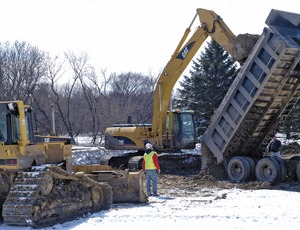
On Oct. 24, the cities of Fargo, N.D., and Moorhead, Minn., moved one step closer to solving a perennial problem within the region: Red River Basin flooding. The U.S. House of Representatives authorized a plan to build nearly $2 billion worth of aqueducts and dams, as well as a 35-mile diversion channel, as part of the Water Resources Reform and Development Act.
The Fargo-Moorhead Diversion Authority, however, is not waiting on federal government approval to get started. Construction continues on making in-town levees—once made of sandbags—permanent, and Denver's CH2M Hill has signed on as the management firm for the Oxbow, Hickson, Bakke Ring Levee, south of Fargo. This initiative will provide a "staging area" to hold several square miles of flood-water during an event.
Most of FMDA's budget for 2014—nearly $70 million—will go toward levee work. The southernmost section of the ring levee will be constructed next summer, CH2M Hill said.
Fargo's role in WRRDA is part of a much larger infrastructure effort to maintain, protect and improve vital waterways, ports and lock systems across the U.S.
Congressional authorization technically allows construction to begin, but federal money must be appropriated each year for the project to be completed. The Army Corps of Engineers says the diversion would take 8.5 years to build, based on a funding stream of $240 million a year.
The Corps, which already has completed a feasibility study and burned through nearly $30 million on design, must wait on construction-funding approval before it can become 100% involved. "But local sponsors can move on construction prior to signing the project partnership agreement and federal appropriation of funds," says Terry Williams, Corps project manager, based in St. Paul, Minn.
Waiting on federal funds is uncomfortable, but North Dakota is in good financial shape to move forward independently on some sections of the diversion plan. "The state has been excellent at getting us money, but it has come with strings attached," says Mike Bittner, lead engineer for the city of Fargo. "They want us to work with the opposition."
A federal lawsuit, brought by the Richland, N.D., and Wilkin, Minn., counties' Joint Powers Authority against the U.S. Army Corps of Engineers, seeks a project review to reduce upstream impacts. "There's a small number of property owners who are opposed to a proposal for a dike around the south side of Fargo," Bittner says. "This is designed to store water in a staging area during an extreme event, and current legislation allows us to buy 30,000 acres to build it. That's what the group is opposed to."
Completing a design that accommodates the needs and wishes of dozens of small communities in the lower Red River Valley is problematic, and it is clearly a challenge to get government agencies in two states to sign off on the same plan. "For instance, the proposed dam control structures proposed are considered 'high hazard,' and Minnesota wants a full environmental impact report done," Bittner tells ENR. "This is in addition to the EIR that the Corps did. The federal concerns are more about cost benefits, and Minnesota's are more environmental."


Post a comment to this article
Report Abusive Comment